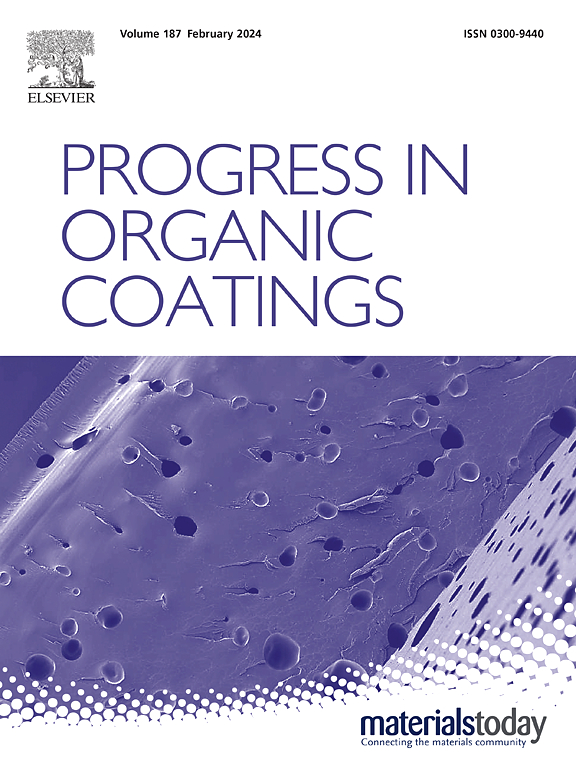A new bio-based waterborne polyurethane/silica coating efficient against common and marine bacteria
IF 6.5
2区 材料科学
Q1 CHEMISTRY, APPLIED
引用次数: 0
Abstract
A new antibacterial waterborne polyurethane (WPU)/silica film was synthesized from the silane-functionalized hydroxyl telechelic natural rubber (SiHTNR) as bio-polyol, dimethylolpropionic acid (DMPA), and hexamethylene diisocyanate (HDI) by emulsion polymerization, then blended with nanosilica particles and antibacterial agents. The SiHTNR was prepared by grafting (3-mercaptopropyl) trimethoxysilane (MPTMS) to the hydroxyl telechelic natural rubber oligomers backbone (HTNR) issued from natural rubber, by thio-ene click reaction. The chemical structure of SiHTNR was confirmed by 1HNMR and 29SiNMR spectroscopy. The SiHTNR was used to successfully synthesize silane-functionalized WPU(SiWPU). The effect of nanosilica (SiO2) content was studied on the morphology of SiWPU/SiO2 particles and the mechanical properties, wettability and thermal properties of films. The TEM image indicated that siloxane functional group was successfully incorporated into the SiHTNR and showed interactions in silica-silica particles and the silica-SiWPU matrix, leading to a larger particle size with increasing nanosilica content. In addition, SiWPU/SiO2 could form films and gave a more opaque yellow film with increasing nanosilica content. The tensile strength and thermal stability of SiWPU/SiO2 films was improved and showed that single Tg and shifted toward higher temperature indicating the compatibility of nanosilica particles and confirmed stiffness characteristics of films with increasing nanosilica content. Finally, it was found that the efficacy of silver nanoparticles, chitosan, and sorbic acid to inhibit growth of E. coli, S. aureus and V. parahaemolyticus depends on the type and content of antibacterial agent. The minimum content of silver nanoparticles, chitosan, and sorbic acid to efficiently inhibit at least of 70 % of bacteria growth was 500 ppm, 200 ppm and 4800 ppm, respectively. However, the inhibition of E. coli growth required high contents of chitosan (600 ppm), while the inhibition of S. aureus required 8000 ppm of sorbic acid. Additionally, the release of these three types of antibacterial agents was investigated in the artificial seawater for 28 days. The behavior of silver nanoparticles and chitosan release showed increasing slope lines until day 14 while sorbic acid release showed increasing slope lines until day 7. After 28 days, the ratio of releasing content to antibacterial agent were 0.438:500Ag, 0.277:1600SB and 0.504:200CS. Comparatively, chitosan exhibits effective inhibiting E. coli, V. parahaemolyticus and S. aureus bacteria growth with a lower dose content, which is suitable for coating. This study offers an opportunity to use SiHTNR as bio-polyol to develop green antibacterial WPU film for coating in marine applications.

一种新型生物基水性聚氨酯/二氧化硅涂料,能有效抵抗常见细菌和海洋细菌
以硅烷功能化羟基远旋天然橡胶(SiHTNR)为原料,以生物多元醇、二甲基丙酸(DMPA)和六亚甲基二异氰酸酯(HDI)为原料,通过乳液聚合法制备了新型抗菌水性聚氨酯(WPU)/二氧化硅膜。将(3-巯基丙基)三甲氧基硅烷(MPTMS)接枝到天然橡胶生成的羟基远旋天然橡胶低聚物主链(HTNR)上,通过硫烯咔嗒反应制备了SiHTNR。SiHTNR的化学结构经1HNMR和29SiNMR谱分析证实。利用SiHTNR成功合成了硅烷功能化WPU(SiWPU)。研究了纳米二氧化硅(SiO2)含量对SiWPU/SiO2颗粒形貌、薄膜力学性能、润湿性和热性能的影响。TEM图像表明,硅氧烷官能团成功嵌入SiHTNR中,并与二氧化硅-二氧化硅颗粒和二氧化硅- siwpu基体相互作用,随着纳米二氧化硅含量的增加,颗粒尺寸增大。此外,随着纳米二氧化硅含量的增加,SiWPU/SiO2可以形成膜,并形成更不透明的黄色膜。SiWPU/SiO2薄膜的抗拉强度和热稳定性均有提高,表现为单Tg,并向高温方向移动,表明纳米二氧化硅颗粒的相容性,并证实了纳米二氧化硅含量增加时薄膜的刚度特性。最后,我们发现纳米银、壳聚糖和山梨酸对大肠杆菌、金黄色葡萄球菌和副溶血性弧菌生长的抑制效果与抗菌剂的种类和含量有关。纳米银粒子、壳聚糖和山梨酸的最低含量分别为500 ppm、200 ppm和4800 ppm,可以有效抑制至少70%的细菌生长。然而,抑制大肠杆菌生长需要高含量的壳聚糖(600 ppm),而抑制金黄色葡萄球菌需要8000 ppm的山梨酸。并对这三种抗菌剂在人工海水中28 d的释放情况进行了研究。到第14天,银纳米粒子和壳聚糖的释放量呈增加趋势;到第7天,山梨酸的释放量呈增加趋势。28 d后,与抗菌剂的释放量之比分别为0.438:500Ag、0.277:1600SB和0.504:200CS。相比之下,壳聚糖在较低剂量含量下对大肠杆菌、副溶血性弧菌和金黄色葡萄球菌的生长有较好的抑制作用,适合作为包被材料。本研究为利用SiHTNR作为生物多元醇开发绿色抗菌WPU涂层提供了契机。
本文章由计算机程序翻译,如有差异,请以英文原文为准。
求助全文
约1分钟内获得全文
求助全文
来源期刊

Progress in Organic Coatings
工程技术-材料科学:膜
CiteScore
11.40
自引率
15.20%
发文量
577
审稿时长
48 days
期刊介绍:
The aim of this international journal is to analyse and publicise the progress and current state of knowledge in the field of organic coatings and related materials. The Editors and the Editorial Board members will solicit both review and research papers from academic and industrial scientists who are actively engaged in research and development or, in the case of review papers, have extensive experience in the subject to be reviewed. Unsolicited manuscripts will be accepted if they meet the journal''s requirements. The journal publishes papers dealing with such subjects as:
• Chemical, physical and technological properties of organic coatings and related materials
• Problems and methods of preparation, manufacture and application of these materials
• Performance, testing and analysis.
 求助内容:
求助内容: 应助结果提醒方式:
应助结果提醒方式:


